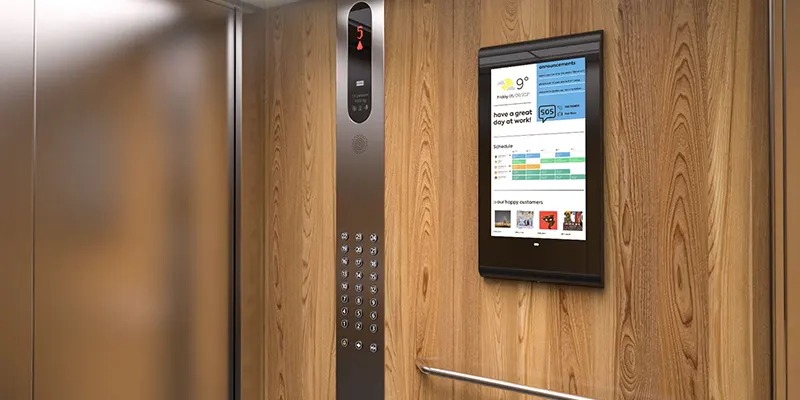What Is an Elevator Screen?
Elevators aren’t just boxes that move us up and down anymore. Today, they’ve become mini communication hubs — all thanks to elevator screens. Instead of staring at blank walls, passengers can now see real-time updates, building announcements, ads, news, and even entertainment during the ride. These screens make the short trip more engaging and informative while helping buildings share useful information instantly.
So, what exactly is an elevator screen, and why are more buildings using them? Simply put, it’s a smart digital display designed to improve communication, enhance the passenger experience, and even create advertising opportunities. Let’s break it down in a clear and friendly way.
What is the function of elevator advertising machines?
An elevator screen is a digital display installed inside or near an elevator to share useful information, advertisements, building updates, or entertainment content. Think of it like a tiny TV fixed in an elevator, but smarter and more interactive.
Its primary purpose?
To make elevator rides informative, engaging, and even profitable for building owners.
Where Elevator Screens Are Used
Commercial Buildings —Corporate updates, stock info, ads
Residential Complexes — Rules, events, security alerts
Hotels & Hospitality — Guest information, restaurant promos
Shopping Malls & Retail Centers — Sales & event promotions
Hospitals & Medical Facilities — Patient flow updates and info
Transportation Hubs — Flight/train info, maps, ads
How Elevator Screens Work
Elevator screens may look simple on the surface, but there’s smart technology powering them behind the scenes. Each screen is connected to a media player or built-in computer that receives content from a central control system. Building managers or advertisers upload and schedule messages through a Content Management System (CMS), allowing updates to happen instantly — whether it's news, emergency alerts, or promotional content.
These screens can work through Wi-Fi, wired networks, or even 4G/5G connections, ensuring consistent and reliable display performance. Sensors and software also help sync the screen with elevator movements, so floor indicators and travel updates appear in real time. All of this creates a smooth, automated system that keeps information fresh and relevant without requiring manual changes.

Choosing the Right Elevator Screen
1.Screen Size & Placement
Selecting the right screen starts with the elevator’s layout. A small cabin might only need a compact display, while larger elevators or lobby areas benefit from bigger screens for better visibility. Placement matters too — screens should be positioned at eye level or where passengers naturally look during the ride.
2.Type of Content Needed
Consider what you want to display. If your goal is simple announcements, a basic screen works. For videos, animations, or interactive building directories, choose a more advanced model that supports rich media or touch functionality.
3.Durability & Safety Standards
Elevator screens must handle movement, vibration, and constant use. Look for fire-rated, tamper-resistant, and vibration-proof designs to ensure safety and long-term reliability in high-traffic environments.
4.Budget Considerations
Finally, balance price with performance. The cheapest option may lack features or durability, while premium systems offer advanced control, analytics, and long-term savings. Consider not only the purchase cost, but also maintenance and content management needs.
Conclusion
Elevator screens are more than just modern décor — they're transforming how buildings communicate and how passengers experience their vertical journeys. From sharing quick news updates to displaying essential alerts and interactive building info, these digital screens bring convenience, clarity, and a touch of sophistication to everyday elevator rides.
With technology becoming smarter and building communication needs growing, elevator screens offer a practical and future-ready solution. Whether in offices, malls, hotels, or residential towers, they help keep people informed, engaged, and connected in the brief moments between floors. As digital transformation continues, we can expect elevator screens to get even more interactive, intelligent, and seamlessly integrated into the smart buildings of tomorrow.
In short, elevator screens turn a few seconds of waiting into a meaningful part of the building experience — making every ride more useful and enjoyable.
FAQs
1. What content can be shown on elevator screens?
News, ads, safety messages, weather, building updates, and navigation info.
2. Are elevator screens expensive?
Prices vary, but options exist for all building types and budgets.
3. Can elevator screens run without internet?
Yes, they can display stored content, but internet enables real-time updates.
4. Are elevator screens safe?
Absolutely — they follow strict fire and safety compliance.
5. Do elevator screens improve property value?
Yes, modern communication tools make buildings look high-tech and appealing.

